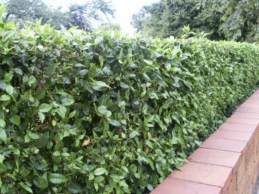Cassinopsis ilicifolia
Cassinopsis ilicifolia Hochst.
Family: Icacinaceae
Common names: Lemon Thorn (English), Lemoentjiedoring (Afrikaans), iMamba eluhlaza (Zulu), iCegceya (Xhosa)
SA Tree No: 420
Description
Description

The lemon thorn is an evergreen, scrambling shrub that can grow up to four metres high and four metres wide. The young stems are a glossy green while the older branches are brownish to pale grey in colour.

Branches are slender, have a trailing habit and grow in a zigzag pattern. Sharp, narrow, green spines occur on the stems. The leaves are glossy, bright green above and dull green below. The leaf margins are either entire or have sharp teeth and curl downwards. Small, star-shaped, white to cream coloured flowers, 2mm in diameter, occur in branched clusters opposite the spines. The flowers appear from September to November (spring to early summer). The fruits are fleshy, bright orange, slightly flattened, smooth, glossy, and are produced from February to May.
Distribution and habitat
Distribution description
The plant grows naturally in montane forest, on forest margins, in wooded kloofs in riverine bush and along streams from the southern and eastern Cape to the eastern Free State, Lesotho, Kwazulu Natal, Swaziland, Gauteng, Mpumalanga and Zimbabwe.
Derivation of name and historical aspects
History
The genus name Cassinopsis is derived from the plant's resemblance to the genus Cassine and the species name ilicifolia is derived as a result of the resemblance of the leaves to those of the holly (genus Ilex)
Uses
Use
The leaves of this plant are eaten by game such as kudu, klipspringer, and grey and blue duiker and are also utilised by goats and cattle. The fruits are eaten by many bird species such as bulbuls, starlings, barbets, pigeons, guineafowl and francolins.
The ripe fruit are edible but do not always have a good taste or flavour. The bark of this plant is used medicinally by some Zulu people for treating dysentery.
Growing Cassinopsis ilicifolia
Grow

The bright, glossy, green foliage, orange fruits and the drooping habit of the stems make this a very attractive plant which can be utilised as a specimen plant in the middle of a lawn or in a small townhouse garden. The plant can also be trained to form a neat compact hedge. It can effectively be used as a decorative outdoor pot plant. It does not have an aggressive root system and can be used close to paved areas, buildings and other structures without causing any damage. The lemon thorn is often utilised in shrubberies and on the borders of gardens and forests. Its dense growth habit makes it an ideal plant to use as a screen (e.g. to screen wind, provide privacy, screen objectionable views). It can also be used to direct traffic when planted on either side of a pathway or drive. Due to the sharp spines and dense growth habit this plant would make an excellent security barrier or hedge to keep unwanted people or animals out of a particular area.
This species is easily propagated from seed, which gives a 70% to 80% germination success rate. Seed should be sown in a well-drained medium and placed in a light environment. Once the seedlings have reached the one leaf stage they can be pricked out and placed singly into bigger containers. The plant can tolerate drought and frost and can be grown in either sun or shade.
This plant belongs to the family Icacinaceae (white pear family). Icacinaceae is a tropical and subtropical family and it is poorly represented in our region with two native tree genera namely Apodytes (three species) and Cassinopsis (two species namely C. ilicifolia and C. tinifolia). The major difference between the two species of Cassinopsis is that C. ilicifolia possesses spines while C. tinifolia does not.
References
- Coates Palgrave, K. 1983 Tree of Southern Africa. Struik: Cape Town.
- Joffe, P. 1993. The Gardener's Guide to South African Plants. Cape Town: Tafelberg Publishers Limited.
- Pooley, E. 1994. The complete guide to Trees of Natal, Zululand and Transkei. Durban: Natal Flora Publications Trust.
- Van Wyk, B. & van Wyk, P. 1997. Field Guide to Trees of Southern Africa. Cape Town: Struik Publishers.
- Venter, F. & Venter J. 1996. Making the most of indigenous trees. Pretoria: Briza Publications.
Credits
Authors
Marc Stern & Thompson Mutshinyalo
Walter Sisulu National Botanical Garden
April 2002
Plant Attributes:
Plant Type: Scrambler, Shrub
SA Distribution: Eastern Cape, Free State, KwaZulu-Natal, Limpopo, Mpumalanga, Western Cape
Soil type: Loam
Flowering season: Spring, Winter
PH: Acid, Alkaline, Neutral
Flower colour: White, Cream
Aspect: Full Sun, Morning Sun (Semi Shade)
Gardening skill:
Special Features:
Horticultural zones










Rate this article
Article well written and informative
Rate this plant
Is this an interesting plant?
Login to add your Comment
Back to topNot registered yet? Click here to register.